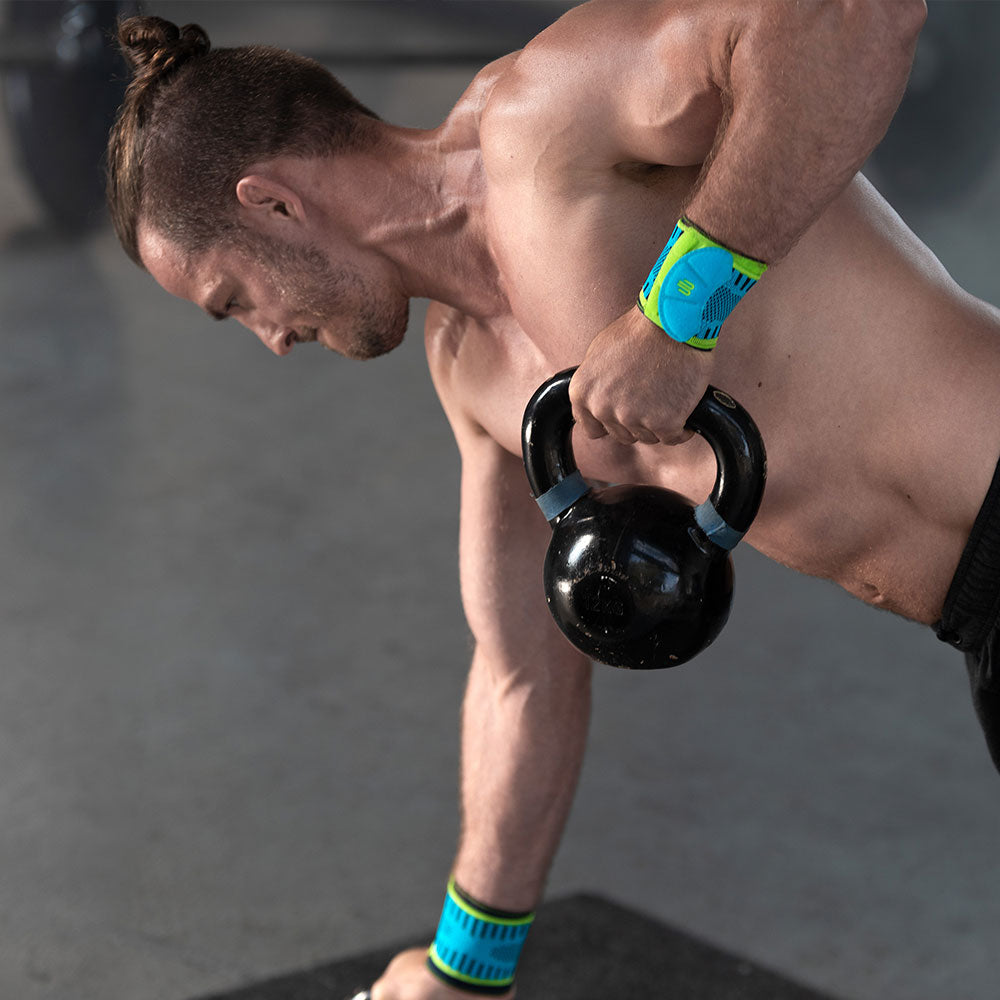Weightlifting Wrist Straps: Why Wear them?

Planning on picking up weightlifting as part of your New Year’s Resolutions? While it’s a great way to build muscle, overlooking key joints like the wrists can make it harder to reach your goals. Fortunately, weightlifting wrist straps (and other important steps) can help you maximise your performance. Here’s how.
Wrist straps can help you lift longer

Sports Wrist Strap
If you’ve ever tried weightlifting, you know that the wrists can get sore pretty quickly, forcing you to do fewer reps, take longer breaks between sets, or even halt your workout entirely. But wrist straps can mitigate these effects. A good pair (like our Sports Wrist Straps) will use a system of pressure and compression to improve your grip and stabilise the wrist joint.
With the added support, all those small stabiliser muscles throughout your wrist and forearm - which tend to overstrain first - have to work a little less. And in return, the larger support muscles will need to kick in later rather than sooner, so you can squeeze in a few more reps before the chain of muscle fatigue kicks off.
Lift more weight

Generally, the larger muscle groups in our arms (like the biceps and triceps) can put up with a lot more than the finer muscles in our forearms. That’s why they take longer to fatigue, and it’s also why it can sometimes seem like your grip is limiting the amount you can lift. Weak wrist muscles or some instability in the joint from an old injury can make matters even worse.
But as we mentioned, wrist straps improve your grip on your weights. You can see this for yourself by pressing into the underside of your forearm: your fingers will naturally start to curl inward and close. So, with your grip issues sorted, you can start lifting heavier and meet your goals sooner.
And avoid injury
Now, the wrist is a complicated joint made up of dozens of ligaments, tendons, and flexor and extensor muscles. When you exercise, you aren’t just engaging the muscles. You’re also using all the connective fibres that let your wrist bend and rotate.
However, repetitive motion (especially coupled with the increased pressure from the weight) can start agitating and damaging all these fine structures. Your FCR tendons may develop micro tears, leading to tendonitis. Your ligaments may stretch too far, causing a sprain or even a tear.
The way wrist straps help mitigate this is through their compression and pressure. Their compression knit will activate key nerves around your wrist, improving your awareness of the joints' placement and movement (aka proprioception). So, you’ll be more aware of if your hand or elbow starts to drift out of alignment, helping you avoid over-flexing, overextending, and overall lifting with bad form.
Compression will also boost blood flow around the area, warming up your muscles and speeding up the delivery of vital oxygen and nutrients. Their pressure, meanwhile, will improve your grip and overall stability of the joint, leaving your tendons and small stabiliser muscles less prone to repetitive strain.
Learn more: Wrist Injury in Sports: Overview and Management
Weightlifting wrist straps: some things to consider

When picking out your straps, you need to be mindful of a couple of things:
- Material. The only good compression is medical-grade compression. Anything less will be ineffective. Additionally, sweaty wrists can get really uncomfortable really quickly, so opt for something breathable.
- Fit. Wrist straps are adjustable by design, but that doesn’t mean they’re one-size-fits-all. Yours should fit cleanly and neatly around wrists without constricting blood flow or leaving areas without pressure. So, an anatomically contoured product (like our Sports Wrist Straps) is the way to go.
- Good structure. Light compression sleeves can improve proprioception and stability, but they won’t offer the level of stabilisation a more rigid strap can.
Beyond straps
So, as we’ve established, weightlifting wrist straps can be a great addition to your weightlifting gear. But they’re not all your wrists need.
- Take it slow. Especially if you’re just starting out, your muscles, tendons, and ligaments won’t be used to the movements and pressure that lifting weights requires. Starting with lighter weights and fewer reps is always better than injuring your wrist and having to wait for it to recover.
- Strengthen your wrists. Exercises like weighted wrist flexion and extension (which we covered in our Golfer’s Elbow article) are a great place to start. You can also invest in a grip strengthener.
- Stretch. Warmed-up and flexible muscles are less prone to injury.
- Mind what you lift. This might go without saying, but don’t start with dumbbells you can barely get off the ground. They won’t just be bad for your wrists but for the rest of your arm, too. And your back. And your knees. While we’re happy to see more lumbar and knee brace sales, we do not want you hurting yourself.
- And last but not least, it’s all in the technique. As we mentioned, your arm should be well-aligned throughout the lift. You'll be less prone to injury and can focus on working out the correct muscle groups instead of overstraining more fragile ones.
To sum up
Weightlifting is a great way to build muscle. Unfortunately, it’s also a great way to overtax the wrists. But luckily, with some strengthening exercises, technique practice, and a good pair of wrist straps, you can avoid injury. And, of course, hit your New Year’s weightlifting goals sooner.
Check out our range of sports supports to help you power through your workouts: Performance
If you require assistance selecting the right product for your needs or wearing the brace, call us on 1300 668 466 or contact us via live chat.
Do you have private health? Most private health extras will cover Bauerfeind Products, check to see if yours is included. Bauerfeind Private Health Insurance Inquiry.



